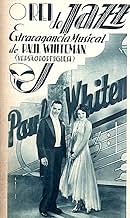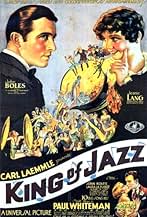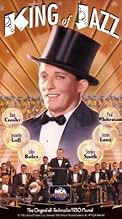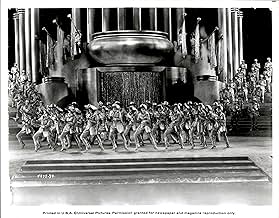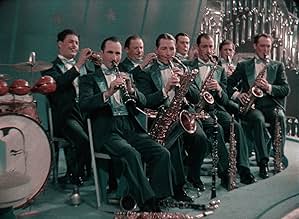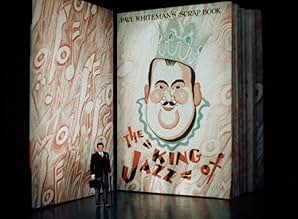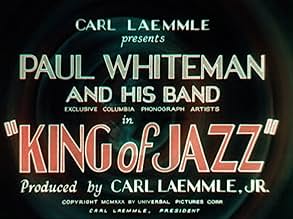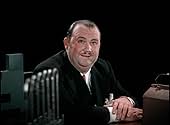IMDb RATING
6.7/10
1.8K
YOUR RATING
A rotund bandleader leads a series of theatrical sketches, dance numbers, special effects, and animated segments.A rotund bandleader leads a series of theatrical sketches, dance numbers, special effects, and animated segments.A rotund bandleader leads a series of theatrical sketches, dance numbers, special effects, and animated segments.
- Directors
- Writers
- Stars
- Won 1 Oscar
- 4 wins total
Harry Barris
- One of the Rhythm Boys
- (as The Rhythm Boys)
Bing Crosby
- One of the Rhythm Boys
- (as The Rhythm Boys)
Al Rinker
- One of the Rhythm Boys
- (as The Rhythm Boys)
Carla Laemmle
- Chorine
- (as Beth Laemmle)
- Directors
- Writers
- All cast & crew
- Production, box office & more at IMDbPro
Featured reviews
Today's audiences could not possibly have any idea of how big in every way Paul Whiteman was during the 1920s. Radio was in its infancy and Paul Whiteman's band was the first orchestra to achieve popularity through that medium. Whiteman records were the biggest sellers of their time. And The King of Jazz was his auspicious debut in motion pictures.
The King of Jazz was also how Whiteman billed himself. He was maybe taking a bit much on to himself with that one, he surely didn't have anything to do with the development of jazz as an art form. But he did help a great deal to popularize it with a wider {white} audience. That was primarily done with that famous jazz concert that Whiteman gave in the mid twenties where George Gershwin's Rhapsody In Blue made its debut. And Rhapsody is reprised here in the movie.
Whiteman's greatest contribution may have been the training of the greatest group of musicians ever. At one time or other, the Dorsey Brothers, Benny Goodman, Bix Biederbecke and so many others were members of the Whiteman orchestra. And of course he was the very first band to hire a vocalist specifically for that role. Previously singers were just musicians who just stopped playing and sang a chorus or two.
Whiteman hired a trio, the Rhythm Boys whose lead singer was Bing Crosby. They are prominent in the film and in fact Bing Crosby made his singing film debut here over the opening credits as he sang Music Hath Charms. He was Whiteman's biggest discovery.
The film is just a musical review done in the style of some of the great musical reviews of the time like the Ziegfeld Follies, Earl Carroll's Vanities, George White's Scandals. Some of the acts are better than others, but's The King of Jazz encapsulates a great era in show business.
The biggest song from the film was It Happened in Monterey sung by John Boles who was Universal's biggest musical star at that point. Boles also got to do the film's finale, The Song of the Dawn, when Crosby who was guzzling a little too much bathtub gin got himself arrested and missed doing the finale which he was scheduled for.
Shortly after recording some of the songs from The King of Jazz the Rhythm Boys left Whiteman and broke up soon after that. Bing Crosby would be heard from again.
For a wonderful piece of nostalgia and filmed in early technicolor at that as an added treat, you can't beat The King of Jazz.
The King of Jazz was also how Whiteman billed himself. He was maybe taking a bit much on to himself with that one, he surely didn't have anything to do with the development of jazz as an art form. But he did help a great deal to popularize it with a wider {white} audience. That was primarily done with that famous jazz concert that Whiteman gave in the mid twenties where George Gershwin's Rhapsody In Blue made its debut. And Rhapsody is reprised here in the movie.
Whiteman's greatest contribution may have been the training of the greatest group of musicians ever. At one time or other, the Dorsey Brothers, Benny Goodman, Bix Biederbecke and so many others were members of the Whiteman orchestra. And of course he was the very first band to hire a vocalist specifically for that role. Previously singers were just musicians who just stopped playing and sang a chorus or two.
Whiteman hired a trio, the Rhythm Boys whose lead singer was Bing Crosby. They are prominent in the film and in fact Bing Crosby made his singing film debut here over the opening credits as he sang Music Hath Charms. He was Whiteman's biggest discovery.
The film is just a musical review done in the style of some of the great musical reviews of the time like the Ziegfeld Follies, Earl Carroll's Vanities, George White's Scandals. Some of the acts are better than others, but's The King of Jazz encapsulates a great era in show business.
The biggest song from the film was It Happened in Monterey sung by John Boles who was Universal's biggest musical star at that point. Boles also got to do the film's finale, The Song of the Dawn, when Crosby who was guzzling a little too much bathtub gin got himself arrested and missed doing the finale which he was scheduled for.
Shortly after recording some of the songs from The King of Jazz the Rhythm Boys left Whiteman and broke up soon after that. Bing Crosby would be heard from again.
For a wonderful piece of nostalgia and filmed in early technicolor at that as an added treat, you can't beat The King of Jazz.
Paul Whiteman was a huge star in the 20s with his terrific jazz band. He might have been the original star band leader. In "The King of Jazz" he also shows himself to be a decent comic actor as well. He's best remembered for his recording of Gershwin's "Rhapsody in Blue," which is featured in this early revue film.
"King of Jazz" is solid entertainment with some lavish and grand-scale production numbers that boast Bing Crosby, John Boles, Laura LaPlante, the Brox Sisters, Jeanie Lang, and of course Whiteman's band.
Best songs are "Happy Feet," "A Bench in the Park," "The Song of the Dawn," and a jazzy "Bluebirds and Blackbirds" number with Crosby as one of the Rhythm Boys (with Harry Barris and Al Rinker).
Al Norman does an amazing dance number to "Happy Feet." Jeanette Loff is rather bland in the "bridal veil" number. The Sisters G in their Louise Brooks hairdos are OK in their dance numbers. And there's a lot of short comedy bits that feature Walter Brennan, Slim Summerville, Grace Hayes, Merna Kennedy, William Kent, and others.
Although I still prefer "The Hollywood Revue of 1929" this revue is also excellent in its use of lavish production numbers, color, and special effects. For fans of early musicals this one is not to be missed.
Whiteman, Crosby, and Boles are all great.
"King of Jazz" is solid entertainment with some lavish and grand-scale production numbers that boast Bing Crosby, John Boles, Laura LaPlante, the Brox Sisters, Jeanie Lang, and of course Whiteman's band.
Best songs are "Happy Feet," "A Bench in the Park," "The Song of the Dawn," and a jazzy "Bluebirds and Blackbirds" number with Crosby as one of the Rhythm Boys (with Harry Barris and Al Rinker).
Al Norman does an amazing dance number to "Happy Feet." Jeanette Loff is rather bland in the "bridal veil" number. The Sisters G in their Louise Brooks hairdos are OK in their dance numbers. And there's a lot of short comedy bits that feature Walter Brennan, Slim Summerville, Grace Hayes, Merna Kennedy, William Kent, and others.
Although I still prefer "The Hollywood Revue of 1929" this revue is also excellent in its use of lavish production numbers, color, and special effects. For fans of early musicals this one is not to be missed.
Whiteman, Crosby, and Boles are all great.
When I first saw this film, I was amazed at some parts and extremely disappointed at others. To be sure, the comedy acts are absolutely abysmal. (Audiences in 1930 didn't find them any funnier than audiences today, so don't feel too bad about hating them.) Also, a lot of the vocalists are grating and painful to listen to. Of course, the parts where the film really shines are the parts that feature the magnificent Paul Whiteman orchestra. This band has been unfairly maligned because although Paul Whiteman was titled "The King of Jazz", his orchestra was not a jazz band per se. But man, were they ever good musicians! Just get a load of the "Meet the Boys" segment towards the beginning...Harry Goldfield doing his best Henry Busse impersonation, Joe Venuti and Eddie Lang playing "Wildcat" in one of their few film appearances, the entire violin section playing a lovely rendition of Caprice Viennois, Chester Hazlett and Roy Bargy doing a pretty rendition of Nola, followed by Wilbur Hall's trombone virtuosity display on the same number. (And let's not forget little Mike Pingitore on "Linger Awhile"!)
Oh yes, and did I mention it has Bing Crosby's first appearance in a feature film? He's with the Rhythm Boys, and man, those guys are HOT! Just get a load of them on "Happy Feet". And check out eccentric dancer Al Norman if you want to see something really crazy.
Last but not least, I would like to mention Wilbur Hall's wonderful trick violin act, and, might I add, the most unique rendition of a Sousa march you'll ever hear in your lifetime. (You haven't heard "The Stars and Stripes Forever" until you've heard it on a bicycle pump!)
Go get yourself a copy and have fun!
Oh yes, and did I mention it has Bing Crosby's first appearance in a feature film? He's with the Rhythm Boys, and man, those guys are HOT! Just get a load of them on "Happy Feet". And check out eccentric dancer Al Norman if you want to see something really crazy.
Last but not least, I would like to mention Wilbur Hall's wonderful trick violin act, and, might I add, the most unique rendition of a Sousa march you'll ever hear in your lifetime. (You haven't heard "The Stars and Stripes Forever" until you've heard it on a bicycle pump!)
Go get yourself a copy and have fun!
1930's King of Jazz is the strangest and most surreal of the early sound cycle of movie studio revues. Very few films shot completely in two-strip Technicolor survive - this is one of them. Warner Bros. probably made the most all-Technicolor films in the early sound era, but since most of them were Vitaphone the films have long since been lost in most cases.
The 1929 and 1930 early sound revues were made by the studios primarily to showcase their talent in an all-talking setting. MGM's "Hollywood Revue of 1929" started the cycle, and did a pretty good job. However, other studios lost sight of the goal and the revues that followed were often clumsily put together and didn't even showcase talent that belonged to the studio.
"The King of Jazz" is a surprise not only because it holds up so well with time, but because it is such a non-typical product for Universal Studios of that era. Universal of the 20's and 30's mainly made westerns for rural moviegoers with an occasional prestige picture and they were beginning to dabble in the horror genre for which the studio is most remembered. However, at this time they were also known for their thrift, which went out the window when they made this film. The film starts out with a cartoon showing how Paul Whiteman - who called himself The King of Jazz - discovered Jazz. What follows are a sequence of musical and comedy routines. This film doesn't make the mistake of trying to sew the numbers together with some maudlin backstage melodrama. It simply presents the numbers in sequence. Most of the talent here is not under long-term contract to Universal. Laura LaPlante is one of the rare exceptions to that rule. The musical numbers are a delight and it is great to see Bing Crosby at the very beginning of his career. The Brox Sisters light up this film just as they did MGM's revue with "Singin in the Rain". The whole thing is so lively and done with with such innovation and energy considering the static camera of the early talkie era that I can't believe Universal has never thought to put this on DVD. They made this one great musical and didn't really make another one until 1936's "Showboat".
My favorite number is "Song of the Dawn" featuring handsome John Boles with his piercing eyes in close up during most of the number belting out a song with that wonderful tenor voice of his. The most memorable number though has got to be "Happy Feet" with dancing shoes and the Sisters G as singing heads in a shoebox. This number also has the aptly named Al "Rubber Legs" Norman showing us the moon dance 28 years before Michael Jackson was even born.
Highly recommended for the fun of it all.
The 1929 and 1930 early sound revues were made by the studios primarily to showcase their talent in an all-talking setting. MGM's "Hollywood Revue of 1929" started the cycle, and did a pretty good job. However, other studios lost sight of the goal and the revues that followed were often clumsily put together and didn't even showcase talent that belonged to the studio.
"The King of Jazz" is a surprise not only because it holds up so well with time, but because it is such a non-typical product for Universal Studios of that era. Universal of the 20's and 30's mainly made westerns for rural moviegoers with an occasional prestige picture and they were beginning to dabble in the horror genre for which the studio is most remembered. However, at this time they were also known for their thrift, which went out the window when they made this film. The film starts out with a cartoon showing how Paul Whiteman - who called himself The King of Jazz - discovered Jazz. What follows are a sequence of musical and comedy routines. This film doesn't make the mistake of trying to sew the numbers together with some maudlin backstage melodrama. It simply presents the numbers in sequence. Most of the talent here is not under long-term contract to Universal. Laura LaPlante is one of the rare exceptions to that rule. The musical numbers are a delight and it is great to see Bing Crosby at the very beginning of his career. The Brox Sisters light up this film just as they did MGM's revue with "Singin in the Rain". The whole thing is so lively and done with with such innovation and energy considering the static camera of the early talkie era that I can't believe Universal has never thought to put this on DVD. They made this one great musical and didn't really make another one until 1936's "Showboat".
My favorite number is "Song of the Dawn" featuring handsome John Boles with his piercing eyes in close up during most of the number belting out a song with that wonderful tenor voice of his. The most memorable number though has got to be "Happy Feet" with dancing shoes and the Sisters G as singing heads in a shoebox. This number also has the aptly named Al "Rubber Legs" Norman showing us the moon dance 28 years before Michael Jackson was even born.
Highly recommended for the fun of it all.
This has an animation and in-camera tricks introduction. The main body is a big musical presenting band leader Paul Whiteman as The King of Jazz. It's an early musical a few years after the introduction of sound. It's a series of musical numbers on a big stage setting. It's a large production but there is no overarching connecting plot. The main connecting device is a giant book that is flipped to get to the next chapter. It's also in Technicolor. There are comedic interstitial scenes. As a historical document, it is absolutely fascinating. It's almost Vaudeville on film in that it's just a lot of performers performing on stage. It is a movie of a bygone era. It's also the first film with Bing Crosby. It was a bit of a failure at the time which may be due to a flood of similar musicals. It's a scattershot of lavish musical scenes without much connective tissue. By the midway point, any novelty is worn out as it all becomes more and more of the same fascinating nothingness. It has no story and it's not concentrating on any single character other than Paul Whiteman who is mostly simply a face. This may not be a great film but it is a fascinating one.
Did you know
- TriviaThe animation sequence, created by Walter Lantz, was the first Technicolor animation ever produced.
- GoofsIn the introduction to ''Ladies of the Press" Grace Hayes is listed as 'Third Reporter' and Kathryn Crawford is listed as 'Fourth Reporter'. This is the reverse of the actual case. Grace Hayes is easily recognizable as the 'Rough Wife' in "Do Things for You". She is the fourth and final reporter in the skit.
- Quotes
Announcer: You don't mean to tell me that you are well-versed in the intricacies of the art of Terpsichore?
Paul Whiteman: No, but I can dance.
- Alternate versionsRestored in 2016 with a running time of 99 minutes. This version replicates the scene continuity of the 1930 release version, including about a minute of exit music. A small amount of footage was not found and is covered by still photographs. This is the version that played at the Museum of Modern Art and Film Forum in 2016, and was released by the Criterion Collection on Blu-ray and DVD in 2018.
- ConnectionsFeatured in The All Talking, All Singing, All Dancing Show (1973)
- SoundtracksRhapsody in Blue
(uncredited)
Music by George Gershwin
Played briefly during the opening credits
Played by Paul Whiteman and Orchestra (as "The Paul Whiteman Orchestra") during the production number
Performed by Roy Bargy (piano)
Danced by Jacques Cartier with clarinet, along with the Russell Markert Girls and The Sisters G
- How long is King of Jazz?Powered by Alexa
Details
- Release date
- Country of origin
- Languages
- Also known as
- King of Jazz
- Filming locations
- Production company
- See more company credits at IMDbPro
Box office
- Budget
- $2,000,000 (estimated)
- Runtime
- 1h 39m(99 min)
Contribute to this page
Suggest an edit or add missing content

